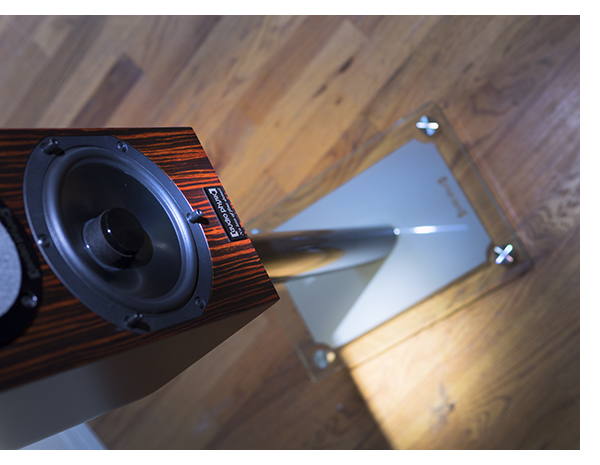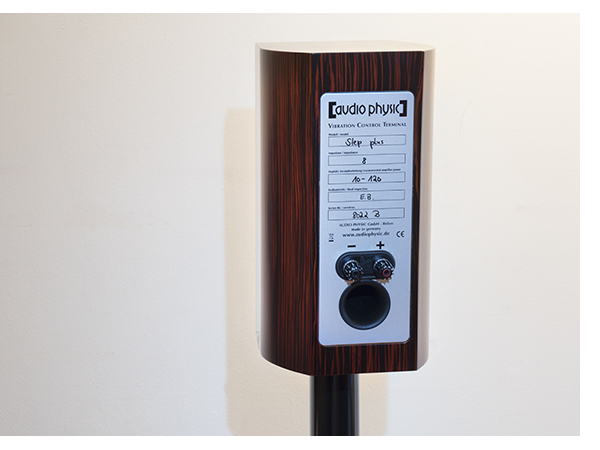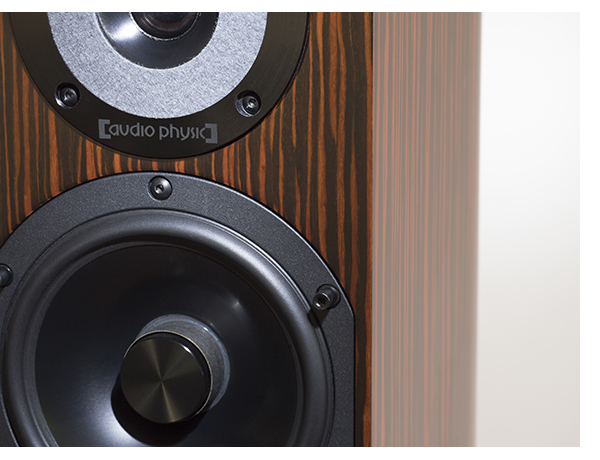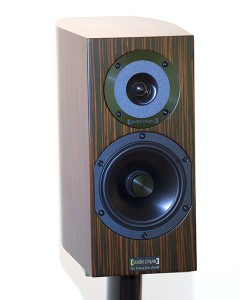The Audio Physic Step plus Step up to great sound!
By Jeff Dorgay Only because I’ve heard it three times today (in the airport, at Home Depot and lunch) listening to the Audio Physic Step plus speakers begins with the Squeeze classic “Pulling Mussels (From the Shell). Not terribly audiophile-y by anyone’s standards, but it’s got some great harmonies, and you can dance to it.
Only because I’ve heard it three times today (in the airport, at Home Depot and lunch) listening to the Audio Physic Step plus speakers begins with the Squeeze classic “Pulling Mussels (From the Shell). Not terribly audiophile-y by anyone’s standards, but it’s got some great harmonies, and you can dance to it.
But seriously, it’s exciting to see what can be coaxed from a small cabinet these days, and the variation on a theme is equally enticing. We had a lovely time with the Step plus’ larger sibling, the Tempo plus a few months ago, and the Step plus is equally good but in a smaller container. For good reason, as the Step plus shares the same 1.75” HHCT III, Ceramic coated Aluminum Hyper-Holographic Cone Tweeter and 5.9” HHCM II, Ceramic coated Aluminum Hyper-Holographic Cone Midrange from the Tempo, sans the latter’s dual 7” woofers. The new plus versions are the latest re-engineered versions of the Step models that have been a favorite world wide for years.
At $2,595/pair in the standard Walnut or Cherry finish or slightly more ($2,795/pair) in the luscious Ebony finish of our review samples, the Step plus speakers look as elegant as they sound. Black and White high gloss are also upgraded finish options. An extra $200 gets you a pair of tempered glass, and metal matching stands, and they provide a sophisticated visual. Though nowhere near as elegant in appearance, my sand filled Sound Anchor stands offer up more bass reinforcement, so take your pick; performance or good looks. Those pairing the Step plus with a subwoofer will have a wider range of stands, as the last few molecules of bass won’t matter.
Imagemeisters
These little darlings image like crazy – every silly audiophile cliché you know applies. Small monitors are a shoe in for their ability to disappear into a room, offering close to the proverbial point source for sound and the Step plus does an amazing job. Everyone who experienced them walked away with their adjective glands exhausted when discussing just how big these small speakers can play.
This is due to the amazing amount of technology incorporated into the speakers, something pretty much unheard of at this price point. Starting with the cabinet itself, designed to minimize standing waves and other reflections, the Step plus takes advantage of an open cell ceramic foam bracing system. This labyrinth-like cabinet interior soaks up unwanted reflections much more effectively than the standard stuffing you might see in a competitors’ speaker. The sloped front baffle also makes for better time alignment, while maintaining a sleek visual.
 According to AP, nearly everything in the plus version of the speaker has been redesigned or updated from the original. The crossover is all new, internal wiring and even the WBT binding posts all contribute to the overall sound. But the biggest part of the performance increase comes from the new third generation Hyper-Holographic driver technology, which takes advantage of a composite aluminum and plastic basket along with active cone dampening on both drivers.
According to AP, nearly everything in the plus version of the speaker has been redesigned or updated from the original. The crossover is all new, internal wiring and even the WBT binding posts all contribute to the overall sound. But the biggest part of the performance increase comes from the new third generation Hyper-Holographic driver technology, which takes advantage of a composite aluminum and plastic basket along with active cone dampening on both drivers.
The result is a more natural, lifelike, engaging presentation. There is a liveliness to these speakers that you might even mistake as coming from an ESL, a delicacy not present in small speakers. Whether it was the gentle bowing of a violin or brushes being stroked across a drumhead, the Step plus gets to the heart of the presentation without being harsh or strident.
Even though the spec sheet claims a sensitivity of 87db with one watt, the Step plus proves easy to drive with any amplifier. With a handful of great amps from Audio Research, Conrad Johnson, Nagra, Pass, PrimaLuna, and Simaudio, the Step plus not only turned in outstanding performances with each one, their high degree of resolution revealed the individual personality of these amplifiers with ease. No small feat for a pair of $2,600 loudspeakers. It’s worth mentioning that matching the Step plus speakers with our Product of the Year winning Simaudio ACE makes for an amazing hi-fi system coming in at just under $6,000.
Going back through the Brian Eno Ambient series proves highly entertaining. Granted, these texturally diverse records won’t tell you a thing about tone or timbre, lesser speakers fail to reveal the minute details and spatial cues going on. Ditto for all of the Jean Michel Jarre albums in my collection. For those of you too young to remember any of these, try the soundtrack from Gone Girl, courtesy of none other than Trent Reznor. This is a hauntingly obtuse recording that feels like it was recorded in some highly processed format like Q Sound. The Step plus rendition of this disc in my 13 x 15-foot listening room has me looking for the Dolby Atmos processor and the other nine speakers; it’s that involving. Paul Weller’s new soundtrack from Jawbone is equally tasty for all the same reasons.
Simple set up
The real key to optimizing the Step plus (as in any good loudspeaker) is to get the tweeters right at ear level. Otherwise, you may feel less than pleased.
If they don’t have you in freak out mode, you don’t have them set up right – it’s that simple. If you don’t start with the AP stands, anything about 24 inches in height will get you somewhere from really close to spot on.
 As with any other high-quality mini monitor, the ultimate tradeoff will be the spot that maximizes bass performance and minimizes midrange cloudiness. The closer to the wall you go, the more bass, but there reaches a point where it begins to compromise the exquisite imaging capabilities. Move the speakers up and back a few inches at a time, and you’ll know immediately when you hit it. The magic disappears, and it disappears abruptly. A similar effect happens moving the speakers side to side, go a little too far, and your hard earned coherence vanishes.
As with any other high-quality mini monitor, the ultimate tradeoff will be the spot that maximizes bass performance and minimizes midrange cloudiness. The closer to the wall you go, the more bass, but there reaches a point where it begins to compromise the exquisite imaging capabilities. Move the speakers up and back a few inches at a time, and you’ll know immediately when you hit it. The magic disappears, and it disappears abruptly. A similar effect happens moving the speakers side to side, go a little too far, and your hard earned coherence vanishes.
The woofer is ported, so keep this in mind, should you even think about bookshelf placement, and take note that the speakers only have single binding posts, so there is no need for bi-wiring.
Fear not, start with the speakers about six or seven feet apart and about four feet from the rear walls, and you’re rocking – they sound great right out of the box. Fiddly audiophiles can coax a bit more imaging performance with a few minutes spent fully optimizing speaker position. These are light speakers, so it’s super easy.
At the end of the day, Fun
Running through every genre of music imaginable, the Step plus does not disappoint. Of course, being a small monitor, you can only crank Zeppelin or your favorite EDM tracks so far. At a certain point, physics works against you, and those little woofers can only move so much air. The quality of bass produced is of high quality, and that’s not what mini monitors are all about in the first place. Going back to Weller’s Jawbone soundtrack for “Jawbone Training” reveals a healthy amount of kick and slam along with the passionate cymbal work provided.
The Audio Physic Step plus is about resolution, and this is delivered. These speakers offer a highly resolving look into the music presented without ever being harsh, strident or fatiguing and that is a tough balance to achieve. It’s obvious that the AP slogan “No Loss of Fine Detail” is delivered on in full.
If you want a highly immersive, three-dimensional music experience in a small to modest room, these are the speakers that should be at the top of your list.
 The Audio Physic Step plus Speakers
The Audio Physic Step plus Speakers
MSRP: $2,599 – $2,799 (finish dependent)
https://vanaltd.com/collections/audio-physic (North American Importer)
Peripherals
Analog Source Technics SL-1200G w/Grado Statement2 cartridge
Phono Preamplifier Conrad Johnson TEA 1s2
Digital Source PS Audio DirectStream memory player and DAC
Amplification PrimaLuna HP Premium (KT 150s installed), Simaudio NEO Ace
Cable Tellurium Q Silver Diamond
Power Equi=



